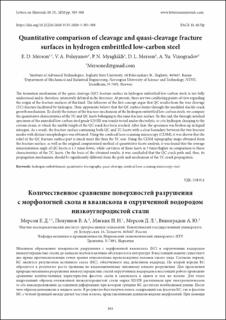| dc.description.abstract | The formation mechanism of the quasi-cleavage (QC) fracture surface in hydrogen embrittled low-carbon steels is not fully understood and is, therefore, intensively debated in the literature. At present, there are two conflicting points of view regarding the origin of the fracture surfaces of this kind. The followers of the first concept argue that QC results from the true cleavage (TC) fracture facilitated by hydrogen. Their opponents believe that the QC surface forms through the modified ductile crack growth mechanism. To clarify the nature of the fracture mechanism of the hydrogen embrittled low-carbon steels, we compare the quantitative characteristics of the TC and QC facets belonging to the same fracture surface. To this end, the through-notched specimen of the annealed low-carbon steel grade S235JR was tensile tested under electrolytic in-situ hydrogen charging to the certain strain, at which the sizable length of the QC crack has been reached. After that, the specimen was broken up in liquid nitrogen. As a result, the fracture surface containing both QC and TC facets with a clear boundary between the two fracture modes with distinct morphologies was obtained. Using the confocal laser scanning microscopy (CLSM), it was shown that the relief of the QC fracture surface part is much more flat than the TC one. Using the CLSM topographic maps obtained from the fracture surface, as well as the original computerized method of quantitative facets analysis, it was found that the average misorientation angle of QC facets is 1.5 times lower, while curviness of these facets is 3 times higher in comparison to those characteristics of the TC facets. On the basis of the obtained results, it was concluded that the QC crack path and, thus, its propagation mechanism, should be significantly different from the path and mechanism of the TC crack propagation. | en_US |

